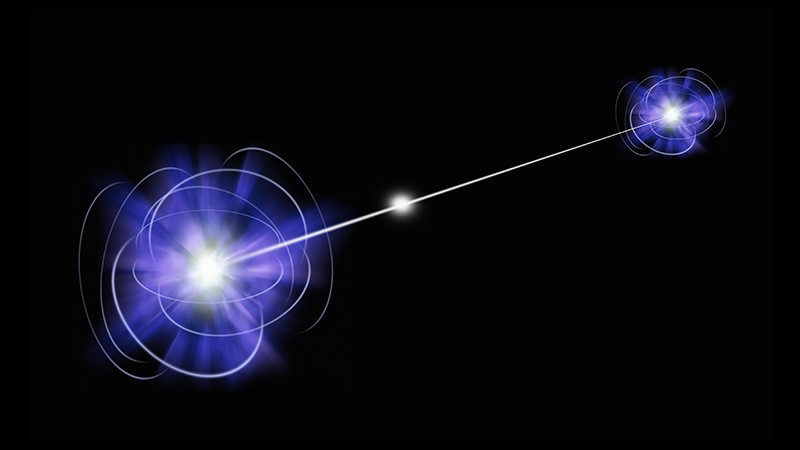NATURE • NEWS:
How ‘spooky’ is quantum physics? The answer could be incalculable
Proof at the nexus of pure mathematics and algorithms puts ‘quantum weirdness’ on a whole new level.
Davide Castelvecchi
 Quantum entanglement is at the centre of a mathematical proof.Credit(量子纠缠是数学证明的核心.来源): Victor De Schwanberg/Science Photo Library
Quantum entanglement is at the centre of a mathematical proof.Credit(量子纠缠是数学证明的核心.来源): Victor De Schwanberg/Science Photo Library
Albert Einstein famously said that quantum mechanics should allow two objects to affect each other’s behaviour instantly across vast distances, something he dubbed “spooky action at a distance”1. Decades after his death, experiments confirmed this. But, to this day, it remains unclear exactly how much coordination nature allows between distant objects. Now, five researchers say they have solved a theoretical problem that shows that the answer is, in principle, unknowable.
The team’s proof, presented in a 165-page paper, was posted on on the arXiv preprint repository on 14 January2, and has yet to be peer reviewed. If it holds up, it will solve in one fell swoop a number of related problems in pure mathematics, quantum mechanics and a branch of computer science known as complexity theory. In particular, it will answer a mathematical question that has been unsolved for more than 40 years.
If their proof checks out, “it’s a super-beautiful result” says Stephanie Wehner, a theoretical quantum physicist at Delft University of Technology in the Netherlands.
At the heart of the paper is a proof of a theorem in complexity theory, which is concerned with efficiency of algorithms. Earlier studies had shown this problem to be mathematically equivalent to the question of spooky action at a distance — also known as quantum entanglement3.
The theorem concerns a game-theory problem, with a team of two players who are able to coordinate their actions through quantum entanglement, even though they are not allowed to talk to each other. This enables both players to ‘win’ much more often than they would without quantum entanglement. But it is intrinsically impossible for the two players to calculate an optimal strategy, the authors show. This implies that it is impossible to calculate how much coordination they could theoretically achieve. “There is no algorithm that is going to tell you what is the maximal violation you can get in quantum mechanics,” says co-author Thomas Vidick at the California Institute of Technology in Pasadena.
“What’s amazing is that quantum complexity theory has been the key to the proof,” says Toby Cubitt, a quantum-information theorist at University College London.
News of the paper spread quickly through social media after the work was posted, sparking excitement. “I thought it would turn out to be one of those complexity-theory questions that might take 100 years to answer,” tweeted Joseph Fitzsimons, chief executive of Horizon Quantum Computing, a start-up company in Singapore.
“I’m shitting bricks here,” commented another physicist, Mateus Araújo at the Austrian Academy of Sciences in Vienna. “I never thought I’d see this problem being solved in my lifetime.”
Observable properties
On the pure-maths side, the problem was known as the Connes embedding problem, after the French mathematician and Fields medalist Alain Connes. It is a question in the theory of operators, a branch of maths that itself arose from efforts to provide the foundations of quantum mechanics in the 1930s. Operators are matrices of numbers that can have either a finite or an infinite number of rows and columns. They have a crucial role in quantum theory, whereby each operator encodes an observable property of a physical object.
In a 1976 paper4, using the language of operators, Connes asked whether quantum systems with infinitely many measurable variables could be approximated by simpler systems that have a finite number.
But the paper by Vidick and his collaborators shows that the answer is no: there are, in principle, quantum systems that cannot be approximated by ‘finite’ ones. According to work by physicist Boris Tsirelson5, who reformulated the problem, this also means that it is impossible to calculate the amount of correlation that two such systems can display across space when entangled.
Disparate fields
The proof has come as a surprise to much of the community. “I was sure that Tsirelson’s problem had a positive answer,” wrote Araújo in his comments, adding that the result shook his basic conviction that “nature is in some vague sense fundamentally finite.”
But researchers have barely begun to grasp the implications of the results. Quantum entanglement is at the heart of the nascent fields of quantum computing and quantum communications, and could be used as the basis of super-secure networks. In particular, measuring the amount of correlation between entangled objects in a communication system can provide proof that it is safe from eavesdropping. But the results probably do not have technological implications, Wehner says, because all applications use quantum systems that are ‘finite’. In fact, it could be difficult to even conceive an experiment that could test quantum weirdness on an intrinsically ‘infinite’ system, she says.
The confluence of complexity theory, quantum information and mathematics means that there are very few researchers who say that they are able to grasp all the facets of this paper. Connes himself told Nature that he was not qualified to comment. But he added that he was surprised by how many ramifications it has turned out to have. “It is amazing that the problem went so deep and I never foresaw that!”
译文:
爱因斯坦说过一句名言,量子力学可以让相距很远的两个物体瞬时影响彼此的行为,他称这种现象为“鬼魅般的超距作用”1。在他死后数十年,实验证明了这种作用。但是,直到今天人们仍然不清楚,在自然允许的条件下,远距离物体间的相互协调可以到一个什么程度?如今,五名研究人员攻克了一个理论难题,他们的证明显示,答案在理论上是不可知的。
该团队在arXiv预印本服务器上传了一篇长达165页的论文2,但尚未经过同行评议。如果评议通过,这篇文章就能一下子解决纯数学、量子力学以及复杂性理论这一计算机科学分支的一连串相关问题。尤其值得一提的是,它还能解决一个已经提出40多年的数学问题。
如果证明成立,“这会是一个非常优美的结论” 。荷兰代尔夫特理工大学的理论量子物理学家Stephanie Wehner说。
论文的核心内容是对复杂性理论中一个定理的证明,与算法效率有关。先前研究显示,这个问题与“鬼魅般的超距作用”(也被称为量子纠缠3)在数学上是等价的。
该定理涉及一个博弈论问题。其中,同为一组的两名参与者不允许直接对话,但能通过量子纠缠协调他们的行动。这样,量子纠缠就能大幅提高这两名参与者的“获胜”次数。但作者证明,要两名参与者计算出一种最优策略在本质上是不可能的。也就是说,他们在理论上能达到的最大协调性是算不出来的。“没有算法能算出量子力学中能达到的最大违背值。”论文的作者之一、加州理工大学的Thomas Vidick说。
“最棒的是,量子复杂性理论是这个证明的关键。”伦敦大学学院的量子信息理论学家Toby Cubitt说。
这篇论文在1月14日发表之后,迅速传遍了社交网络。人们对此十分激动,新加坡初创公司Horizon Quantum Computing的首席执行官Joseph Fitzsimons在推特上写道,“我本来以为这个问题就和其他复杂性理论的问题一样,要用上一百年才能解决。”
奥地利科学院的物理学家Mateus Araújo说:“我被吓到了,我从没想过这个问题会在我有生之年得到解决。”
可观测量
在纯数学领域,这个问题被称为“Connes嵌入问题”,其名称来源于法国数学家、菲尔兹奖获得者Alain Connes。这个问题其实属于算子理论的范畴,而算子理论是1930年代衍生出的一个数学分支,目的是为了给量子力学的发展奠定数学基础。算子是数的矩阵,行列数或有限或无限。每个算子都能表示物理对象的一个可观测量,在量子力学中有着非常重要的作用。
Connes在1976年发表的论文4中,用算子语言提出了一个问题:有着无限可测量变量的量子系统是否能用只有有限变量的简单系统近似?
而Vidick等人给出的答案是:不能。本质上说,量子系统是不能用“有限”系统近似的。物理学家Boris Tsirelson5曾重新提出过这个问题,基于他的研究,Vidick等人的证明也可以推及:两个量子系统在超距纠缠时所能产生的关联性也是无法计算的。
异“域”结合
证明结果让领域中的许多人都深感惊讶。“我以为Tsirelson问题的答案绝对是肯定的。”Araújo在评论中写道。他本来相信的是,“从某种模糊的意义看,大自然在本质上是有限的”。如今,这个结果动摇了他的基本信仰。
研究人员对这个证明的真正意义还在消化中。量子纠缠是量子计算和量子通信这两个新兴领域的核心,可以用来实现超级安全的网络。特别重要的是,通过测量通信系统中纠缠对象间的关联性,就可以证明它未被窃听。不过,Wehner认为这个结论可能不会有太多技术上的影响,因为所有涉及量子系统的应用都会使用“有限”的系统。他还说,事实上,想要在本质“无限”的系统上测试量子怪诞性,单单是设计出这样的实验都是很困难的。
由于这篇论文融合了复杂性理论、量子信息和数学的多个方面,能完全理解论文的人屈指可数。Connes本人告诉《自然》,自己也不够格评论。但他表示,自己惊讶于这篇论文会有如此多的衍生影响。“这个问题竟然被研究地如此深入,这是我当初没想到的!”
Nature 577, 461-462 (2020)
doi: 10.1038/d41586-020-00120-6
References
- 1. Einstein, A., Podolsky, B. & Rosen, N. Phys. Rev. 47, 777 (1935).
- 2. Ji, Z., Natarajan, A., Vidick, T., Wright, J. & Yuen, H. https://arxiv.org/abs/2001.04383 (2020).
-
- 3. Vidick, T. et al. Not. Am. Math. Soc. 66, 1618–1627 (2019).
- 4. Connes, A. Ann. Math. 104, 73–115 (1976).
- 5. Tsirelson, B. Hadronic J. Suppl. 8, 329–345 (1993).